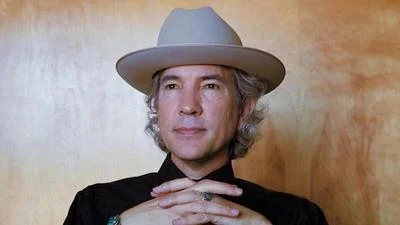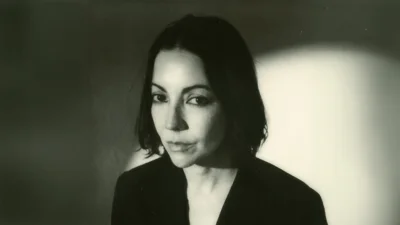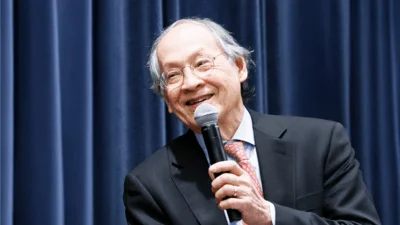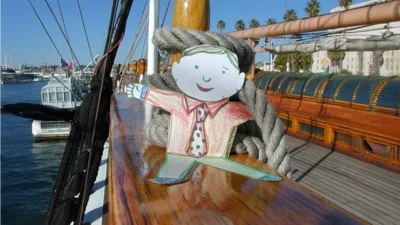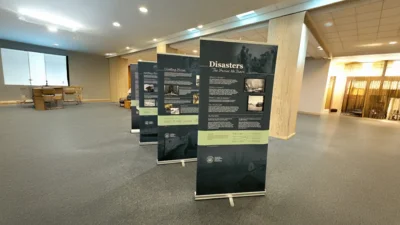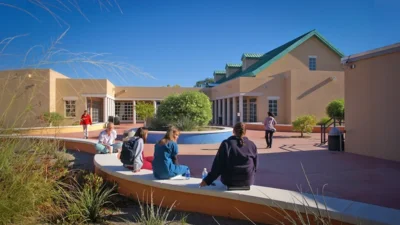I went to the Albuquerque Museum of Art to see the newly acquired Richard Diebenkorn painting, Untitled (Albuquerque), 1952. But my eye caught another newly obtained work, Yoshiko Shimano’s Wisdom of Water (2016). Walking up to the large triptych, I was immediately struck by the fact that it is a woodcut on silkscreen and linoleum. At 96 x 137-1/4 inches it’s an impressive work.
The artwork is cityscapes of Tokyo (Edo) and Amsterdam, accompanied by bicycles, ships, rickshaws, windmills, and homes (Rembrandt and Anne Frank) and a castle (Edo Castle). As the description of the work states, “Shimano explores her intersecting interests in the cultural history of the city, its diligent planning and rapidly changing orientation to the outside world.”

Yoshiko Shimano at work in her studio. Photo provided by artist
Born in Tokyo, Shimano is now an Albuquerque resident and professor at the University of New Mexico. I was able to talk with Shimano about the artwork.
I’m captivated by the name of the piece, Wisdom of Water. Though the work is of a city, your title focuses on water. Why is this?
Japan was segregated and separated for years from much of the world. But Japan was secretly working with China, Portugal, and the Netherlands in various capacities. Water was the connecting feature with these countries; the use of water as transportation in the countries was comparable.
When you look at the cityscapes of the countries, there’s similarities between them. I was particularly struck by the parallels between Amsterdam and Tokyo, though totally different, there was inherent connections.
As an example: Emperors and Empresses ruled Japan, Kings and Queens the European countries. So, too, the canals and transportation systems of the cities.

Wisdom of Water (2016) by Yoshiko Shimano. Photo provided by artist
In Wisdom of Water, I overlay two maps, the Amsterdam canal system and Tokyo canal system, to highlight the relationships on how water helped with transportation. But more importantly, the relationship water has to the cities’ structure and design.
I’m interested in why you incorporate Rembrandt and Anne Frank’s homes in the art. To my knowledge, neither spent time in Japan.
In 2015, I was doing a residency in Amsterdam. I visited the homes of Anne Frank and Rembrandt. I was fascinated by the resemblances of architecture and urban design between Tokyo and Amsterdam, particularly the Tokyo train station and the Amsterdam train station.
During the residency, I saw the film installation by William Kentridge "More Sweetly Play the Dance" at EYE Film Museum in Amsterdam. The beautiful silhouette movements of the dancers and objects were a strong influence and inspiration on Wisdom of Water.
Practically, how Tokyo and Amsterdam were built are alike, something I wanted to capture. In Amsterdam, there’s bike lanes; in Tokyo, car lanes. But they are comparable in many ways.
The Edo Castle was included to show how landmarks help define a city. Buildings give direction, helping demarcate a landscape.
The Edo Period of Japan (1603-1868) was fascinating. The era had great art, poetry (Basho, for example), and marvelous cultural institutions. Japan began to open to the outside world. What is it about the conjoining of Eastern and Western ideals that fascinate you?
Because I was in the Netherlands, my interest in how ideas connect—between cultures—is captivating to me. Though separated by many miles we share so much in common.
As an example, New York has an East to West grid. This is like Kyoto. And many other cities follow suit. The similar expressions of humanity, how we think and create, are inspiring. Wherever you go, people are more alike than different.
Wisdom of Water will remain accessible through the eMuseum site. You can view it here:https://albuquerque.emuseum.com/objects/142948/wisdom-of-water?ctx=38fbe803c95f1f3b0149345121340da9dbde8117&idx=0.
Also, a forthcoming Abstracting Nature exhibition will open at ABQ Museum of Art on June 21. The exhibition will feature Shimano’s work. The website is here: https://www.cabq.gov/artsculture/albuquerque-museum/exhibitions-1/abstracting-nature.
To learn more about Yoshiko Shimano, click here: https://yoshikoshimano.com.
Brian C. Nixon, Ph.D., is Chief Academic Officer and professor at Veritas International University in Albuquerque. As a writer, musician, and artist, his interests surround the philosophical transcendentals: truth, beauty, and goodness. You can contact Brian via his Bandcamp email address: https://briancharlesnixon.bandcamp.com

